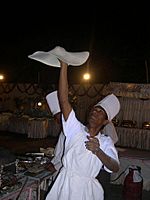Manda roti facts for kids

Manda roti being prepared in India on an upturned vessel
|
|
| Alternative names | Mandige, rumali, or veechu roti |
|---|---|
| Place of origin | |
| Associated national cuisine | Indian |
| Main ingredients | Atta and maida flour |
Manda roti (also called Rumali roti) is a traditional Indian roti which finds mention in religious Sanskrit literature like purāṇas to ayurvedic & pākakalā texts like Nighantus & Bhojanakutūhala. This roti is extremely thin and limp, and served folded like a handkerchief. Manda roti is usually made with a combination of whole wheat atta flour and white wheaten maida flour and cooked on the convex side of a kadahi. It is also known as veechu roti in Tamil or Mandige in other parts of South India.
Etymology and history
The word Manda roti is compound of two words: Manda and Roti. The word manda is derived from Sanskrit word- Maṇḍaka and roti from Sanskrit word- Roṭikā. Maṇḍaka is wheat based flatbread which finds several mentions in Sanskrit literature from religious scriptures like Skanda purāṇa to Pākakalā texts like Bhojanakutūhala. As per Skanda purāṇa, Maṇḍaka are thin circular symmetrical flat cakes prepared from wheat flour. In Bhojanakutūhala, the detailed recipe of maṇḍaka is mentioned where it is described they are cooked on upturned pot. In Madanapala Nighantu, several varieties of madakas are mentioned which are prepared by adding vikola, karkaṭa, drākṣā and kantakäri etc.
See also
 In Spanish: Rumali roti para niños
In Spanish: Rumali roti para niños



